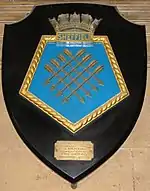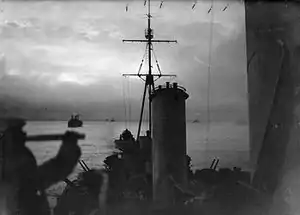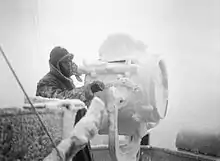 Sheffield underway in 1944 | |
| History | |
|---|---|
| Name | HMS Sheffield |
| Namesake | Sheffield |
| Builder | Vickers-Armstrongs, High Walker |
| Yard number | 5 |
| Laid down | 31 January 1935 |
| Launched | 23 July 1936 |
| Commissioned | 25 August 1937 |
| Identification | Pennant number: C24 |
| Nickname(s) | Shiny Sheff |
| Honours and awards |
|
| Fate | Scrapped at Faslane, 1967 |
| Badge |  |
| General characteristics | |
| Class and type | Town-class light cruiser |
| Displacement |
|
| Length | |
| Beam | 62.25 ft (18.97 m) |
| Draught | 17.0 ft (5.2 m) |
| Installed power | 75,000 shp |
| Propulsion | |
| Speed | 32 knots (59 km/h) |
| Complement | 748 |
| Sensors and processing systems | Type 79Y radar from August 1938[1] |
| Armament |
|
HMS Sheffield was one of the Southampton sub class of the Town-class cruisers of the Royal Navy during the Second World War. She took part in actions against several major German warships. Unlike most Royal Navy ships of her time, her fittings were constructed from stainless steel instead of the more traditional brass. This was an attempt to reduce the amount of cleaning required on the part of the crew. Her nickname, the "Shiny Sheff", stemmed from this. A prototype radar system was placed into service in August 1938 on the Sheffield. It was the first vessel in the Royal Navy to be so equipped.[2]
Building
Vickers-Armstrongs built Sheffield at High Walker, Newcastle upon Tyne. Her keel was laid on 31 January 1935, she was launched on 23 July 1936 and she was completed on 25 August 1937.[3]
War service

At the outbreak of war, Sheffield served with the 18th Cruiser Squadron, patrolling the Denmark Straits and then, in April 1940, she was engaged in the Norwegian Campaign. After a short spell carrying out anti-invasion duties in the English Channel, she joined Force H, based in Gibraltar. During that time, she operated in the Mediterranean and the Atlantic until the year's end, and took part in Operation White and the battle of Cape Spartivento.
In 1941, she participated in Operation Grog, the shelling of Genoa, in operations against Vichy convoys and supporting air reinforcements to Malta. In May, Sheffield took part in the sinking of the German battleship Bismarck, narrowly escaping a friendly fire torpedo attack by the aircraft carrier Ark Royal's Fairey Swordfish; eleven torpedoes were dropped and only defective Duplex exploders and fine ship handling saved her from disaster.[4] (In the report of the attack, Admiral Sir John Tovey, commanding Home Fleet, was told only no hits were scored on Bismarck.[5] The reaction of Sheffield's crew "has not made its way into the official records".)[6] On 12 June, she located and sank one of Bismarck's tankers, Friedrich Breme. After the destruction in early October 1941 of another German supply ship, Kota Penang, (aided by the cruiser Kenya), Sheffield returned to Britain.
She was occupied on Arctic convoys until hitting a mine off Iceland on 3 March 1942 and was under repair until July. After more Arctic convoys, Sheffield joined the forces supporting the Allied landings in North Africa (Operation Torch) in November. In December 1942, Sheffield and Jamaica formed "Force R", under the command of Rear-Admiral Robert Burnett (in Sheffield), which provided cover for Convoy JW 51B. The convoy was attacked by a strong German surface force. In the ensuing action (Battle of the Barents Sea), the Germans withdrew and Sheffield sank the German destroyer Friedrich Eckoldt, while also damaging the cruiser Admiral Hipper, Eckoldt mistaking Sheffield for Hipper. During this engagement, the destroyer Achates and the minesweeper Bramble were sunk by gunfire of the two German vessels.

_MOD_45139960.jpg.webp)
In February 1943, Sheffield moved to operate in the Bay of Biscay and, in July and August, she supported the landings at Salerno (Operation Avalanche). Returning yet again to the Arctic, she took part in the sinking of the battleship Scharnhorst off the north coast of Norway, in late December.
In 1944, Sheffield was an escort for the Royal Navy carrier force that executed a series of air attacks on the German battleship Tirpitz, between April and August. These had limited success and responsibility was passed to the Royal Air Force.
A lengthy refit in Boston and in Britain kept Sheffield out of action until after the end of the war.
Post-war
The refit was completed in May 1946 and Sheffield arrived at her new base, the Royal Naval Dockyard in the Imperial fortress colony of Bermuda, on the 30 August, 1946, for duties as flagship on the America and West Indies Station. Her commanding officer, Captain K. G. Harkness, D.S.C., was also the Chief Staff Officer to the Commander-in-Chief, Vice-Admiral Sir Irvine Glennie.[7][8] She departed Bermuda, and the station, on 26 October, 1948, for England, replaced as flagship on the America and West Indies Station by HMS Glasgow.[9][10]

On 12 October, 1951, Sheffield returned to Bermuda again as flagship of the America and West Indies Station, replacing HMS Superb.[11] From June 1952 to May 1953, her commanding officer was Capt. John Inglis, who was to become director of Naval Intelligence in July 1954.[12] In 1953 she took part in the Fleet Review to celebrate the Coronation of Queen Elizabeth II.[13] On 18 October, 1954, she was replaced as flagship of the America and West Indies Station by HMS Superb, leaving Bermuda the same day to decommission at Portsmouth.[14]
.jpg.webp)
There were further refits in 1949/50,1954 and 1956-7 when her bridge was enclosed, a lattice foremast added, and a comprehensive anti nuclear and biological washdown installed in 1959–60. Her final light anti-aircraft outfit consisted of eight twin Bofors Mk 5 and 2 single Bofors Mk 7.[15] In 1955, she played the part of the cruiser Ajax in the war film The Battle of the River Plate. She went into reserve in January 1959, but as the refit of HMS Swiftsure was stopped due to structure weakness, and the Town cruisers, was considered far more comfortable and able to carry far more light AA, HMS Sheffield was the final World War II cruiser to be refitted for possible use as a GFS monitor, and became flagship of the Reserve Fleet and served again at sea in 1960 and then as an accommodation ship until September 1964, when she was placed on the disposal list. She was widely considered as a historic and great British warship, justifying preservation and a cruiser which maintained far more the character and fit of a World War II cruiser compared with the more modified Belfast. However, by 1966, examination showed Sheffield had deteriorated too much in unmaintained reserve in Fareham Creek and could not be preserved.
Her equipment was removed at Rosyth in 1967 and she was then broken up at Faslane in the same year. The stainless steel ship's bell, which was made by Hadfield's of Sheffield, was preserved and today hangs in Sheffield Cathedral along with her battle ensign.
Citations
- ↑ Macintyre, Donald, CAPT RN "Shipborne Radar" United States Naval Institute Proceedings September 1967 p.75
- ↑ Coales, J. F., and J. D. S. Rawlinson; "The Development of Naval Radar 1935-1945", J. Naval Science, vol. 13, nos. 2-3, 1987.
- ↑ "Sheffield". Tyne Built Ships. Shipping and Shipbuilding Research Trust. Retrieved 25 September 2022.
- ↑ Stephen, Martin. Sea Battles in Close-up (Shepperton, Surrey: Ian Allan, 1988), Volume 1, pp.89-90.
- ↑ Stephen, p.91.
- ↑ Stephen, p.89.
- ↑ "Sheffield Due At Bermuda Tomorrow: Flagship for C.C. Here; Has Notable War Record; BERMUDIAN IS AMONG OFFICERS IN CRUISE". The Royal Gazette. City of Hamilton, Pembroke, Bermuda. 29 August 1946.
- ↑ "New Flagship Arrives at R.N. Station Here: Cruiser Sheffield Will Be Followed by H.M.S. Kenya". The Royal Gazette. City of Hamilton, Pembroke, Bermuda. 31 August 1946.
- ↑ "Sheffield Leaves Today: Visited By 175,000 During 5 "Showing The Flag" Cruises". The Royal Gazette. City of Hamilton, Pembroke, Bermuda. 26 October 1948. p. 1.
- ↑ "Farewell Dance For "Sheffield" Men". The Royal Gazette. City of Hamilton, Pembroke, Bermuda. 26 October 1948. p. 8.
- ↑ "H.M.S. Sheffield Arrives To Become New flagship". The Royal Gazette. City of Hamilton, Pembroke, Bermuda. 13 October 1951.
- ↑ Houterman, Hans; Koppes, Jeroen. "Inglis, (Sir) John Gilchrist Thesiger". Royal Navy (RN) Officers 1939-1945. www.unithistories.com. Retrieved 16 July 2011.
- ↑ Souvenir Programme, Coronation Review of the Fleet, Spithead, 15th June 1953, HMSO, Gale and Polden
- ↑ "Queen's Colour Handed Over To New Flagship". The Royal Gazette. City of Hamilton, Pembroke, Bermuda. 19 October 1954.
- ↑ Friedman, Norman (2010). British Cruisers. Seaforth. p. 282. ISBN 978-1-84832-078-9.
References
- Campbell, N.J.M. (1980). "Great Britain". In Chesneau, Roger (ed.). Conway's All the World's Fighting Ships 1922–1946. New York: Mayflower Books. pp. 2–85. ISBN 0-8317-0303-2.
- Colledge, J. J.; Warlow, Ben (2006) [1969]. Ships of the Royal Navy: The Complete Record of all Fighting Ships of the Royal Navy (Rev. ed.). London: Chatham Publishing. ISBN 978-1-86176-281-8.
- Friedman, Norman (2010). British Cruisers: Two World Wars and After. Barnsley, UK: Seaforth Publishing. ISBN 978-1-59114-078-8.
- Lenton, H. T. (1998). British & Empire Warships of the Second World War. Annapolis, Maryland: Naval Institute Press. ISBN 1-55750-048-7.
- McCart, Neil (2012). Town Class Cruisers. Liskeard, UK: Maritime Books. ISBN 978-1-904-45952-1.
- Raven, Alan & Roberts, John (1980). British Cruisers of World War Two. Annapolis, Maryland: Naval Institute Press. ISBN 0-87021-922-7.
- Rohwer, Jürgen (2005). Chronology of the War at Sea 1939–1945: The Naval History of World War Two (Third Revised ed.). Annapolis, Maryland: Naval Institute Press. ISBN 1-59114-119-2.
- Waters, Conrad (2019). British Town Class Cruisers: Design, Development & Performance; Southampton & Belfast Classes. Barnsley, UK: Seaforth Publishing. ISBN 978-1-5267-1885-3.
- Whitley, M. J. (1995). Cruisers of World War Two: An International Encyclopedia. London: Cassell. ISBN 1-86019-874-0.
External links
- HMS Sheffield Association Official Website at the Wayback Machine
- Sources for the study of HMS Sheffield Produced by Sheffield City Council's Libraries and Archives